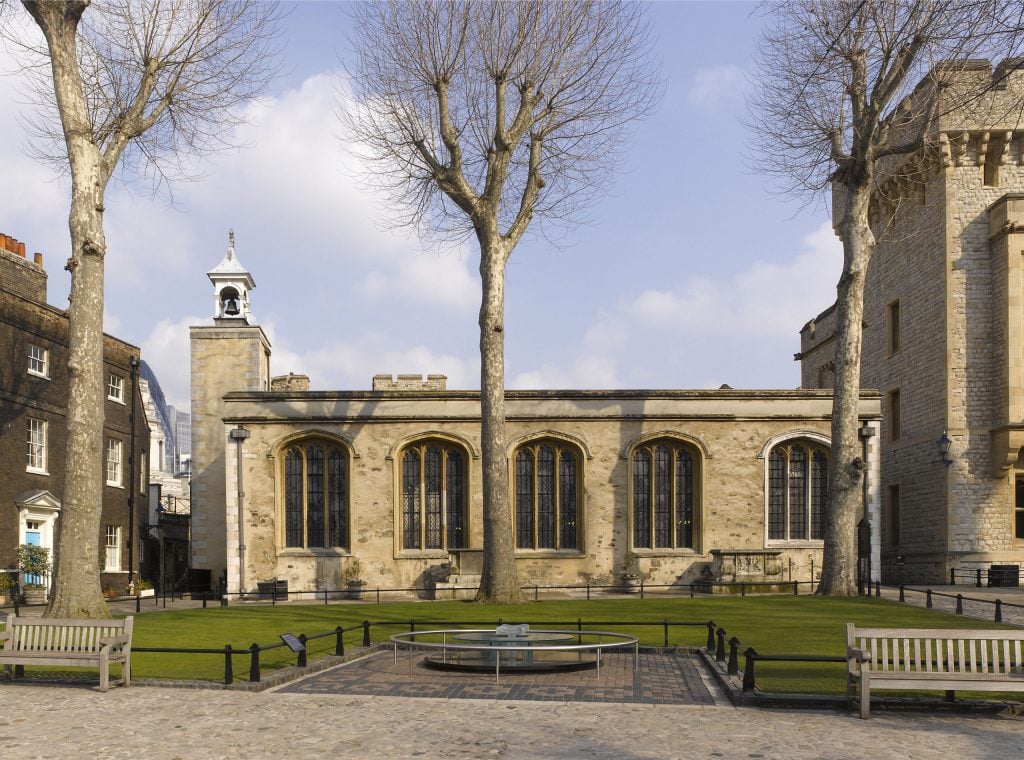The most significant excavation in a generation is underway at the Tower of London and it’s promising to “re-draw the map of the medieval fortress” and shed light on some of the people who lived, worked, worshiped, and died at the parish church of the Tower of London.
First built in the 12th century, the Chapel Royal of St Peter ad Vincula—Vincula, meaning “chains” in Latin, refers to the Apostle’s captivity in Jerusalem—was the place of worship for inhabitants of the Tower and the occasional monarch who wished to be seen acting piously. It has been destroyed, rebuilt, and even relocated several times over the past 900 years and is best known as the burial site of Anne Boleyn, Thomas More, and Lady Jane Grey, figures who were all imprisoned and executed at the Tower. Today’s excavations, which are taking place as the chapel installs a new elevator, are revealing the Tower’s more ordinary citizens.
“The main change has been who worshipped at the church and who got to be buried there,” Alfred Hawkins, curator of historic buildings at the Tower of London, said over email. “Prior to the reign of Henry III [in the 13th century], we have no real understanding of who used the building, but Henry refurbishes the church and uses it as a royal chapel. For the rest of its history, it appears to have been the parish church for residents of the Tower holding regular baptisms, marriages and funerals, as it does today.”

The Chapel Royal of St Peter ad Vincula. Photo: courtesy HRP.
A trial run in 2019 created a blueprint for Historic Royal Palaces (HRP), the charity responsible for the Tower of London, to follow. Under guidance from Historic England, HRP runs the excavation alongside Pre-Construct Archaeology, with experts from Cardiff University handling the forensic analysis. The trial pit unearthed two skeletons, a middle-aged woman and a young boy, who were found to have been members of the Tower community in the early 16th century. It was the first time subjects from the Tower had undergone modern forensics with researchers learning that the woman had maintained a rich diet (with lots of sugars) and that the boy caused had suffered from a period of stress, likely from disease or malnutrition, from which he recovered a short time before his death.
Researchers have found a mass grave that may date to the Black Death. Photo: courtesy HRP.
“Our work uses a biomolecular technique known as isotope analysis, which tells us about health, diet and mobility in the past, all from a tiny fragment of a tooth,” Cardiff University’s Katie Faillace said in a statement. “This cutting-edge method has unparalleled potential for reconstructing the experiences of the people who lived and died at the Tower, allowing us to build a rich picture of individuals’ lives.”
This year’s excavations go deeper, reaching as far down as 10 feet, and have already uncovered the remains of more than 20 individuals. Together, they cover a broad span of English history. A 14th-century collection of burials is believed to be a mass grave from the Black Death, which hit London in 1348 and is estimated to have killed 15 percent of the city’s population. Others were more attentively buried. Three skeletons from the 12th or early 13th century were placed in coffins, one with a shroud, practices that researchers say are suggestive of “high-status.” A separate burial from the same period includes pots containing charcoal, which is almost without precedent in England.
Researchers have found the foundations of Edward I’s chapel. Photo: courtesy HRP.
Beyond the bones, the excavation is coloring in some blanks in the Chapel’s architectural history. The current structure situated within the Tower’s Inner Ward was built for Henry VIII in 1520 after an earlier edifice constructed by the 13th century king Edward I burned down. The foundations of that original building, together with evidence of a large burning event, have now been discovered.
Drawing of the Chapel Royal of St Peter ad Vincula. Photo: the Print Collector/Getty Images.
Elsewhere, archaeologists have found a compacted layer of stone that may related to works carried out by Henry III in 1240 as well as a section of wall that may have formed part of the first chapel built on the site in the first years of the 1100s by Henry I.
“This is just the tip of the iceberg,” Jane Sidell, a lead at Historic England, said in a statement. “There is so much more to learn through further analysis about the people as well as the buildings of one of England’s most evocative historic monuments.”
link

